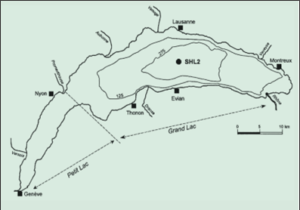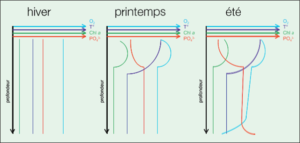
This manuscript presents an exhaustive analysis of a physicochemical dataset collected from Lake Geneva since 1957, offering a detailed exploration of its long-term environmental evolution. This study encompasses an array of cycles and trophic states that the lake has undergone. A critical finding is the significant influence of human activities within the catchment area, notably the introduction of substantial quantities of nutrients, especially phosphorus, into the lake’s ecosystem. This anthropogenic impact culminated in a marked ecological decline between the 1960s and 1970s, characterized by a phase of eutrophication. This period saw a surge in algal blooms and a consequent decrease in water transparency.
In the 1970s, strategic interventions were implemented to address this environmental challenge. These measures, including the enhancement of phosphorus treatment at sewage facilities in the catchment area and the nationwide ban on phosphated detergents in Switzerland, proved instrumental in reducing the influx of nutrients. Consequently, a significant reduction in the lake’s phosphorus levels was observed by the 1980s. The lake is currently undergoing a re-oligotrophication process, with phosphorus concentrations indicating a mesotrophic state. However, it is noteworthy that the biological components of the lake are exhibiting a slower recovery rate in adapting to reduced nutrient levels, in contrast to the more immediate response noted during the eutrophication phase.
Despite the progress achieved, ongoing vigilance and efforts are essential to continuously monitor, identify, and manage potential sources of phosphorus pollution. This proactive approach is vital for maintaining the lake’s ecological balance and ensuring it remains free from significant algal proliferation.
Copyright © 2023 Sarah Adam. This is an open access article distributed under the Creative Commons Attribution License, which permits unrestricted use, distribution, and reproduction in any medium, provided the original work is properly cited.

Figure 1: TLake Geneva and location of the SHL2 sampling point.
With a theoretical water residence time of 12 years, tritium dating measurements have unveiled residence times varying from 5 years in surface layers to approximately 20 years at the lake bottom [2] [3]. Functioning as a hollow lake with a hollow index of 6.3 (the ratio between average depth and surface area), Lake Geneva encounters challenges in achieving thorough mixing. Classified as a warm monomictic lake due to its altitude and morphology, it experiences a solitary mixing period in winter. Complete water column mixing is infrequent and necessitates cold winters and robust winds. Since the 1970s, only five instances of complete mixing have been recorded (1970, 1971, 1981, 1986, and 2005). The lake’s dynamics exhibit a high sensitivity to winter climatic conditions.
The watershed’s surface area (7393 km2) in relation to the lake is 13, underscoring the significance of activities and land use patterns in the watershed. Comprising uncultivated land, forests, pastures, arable land, and glaciers, alongside a considerable urban population exceeding 950,000 permanent inhabitants, the watershed significantly influences the lake’s ecosystem. The Rhône, the primary tributary, contributes 3/4 of the total water flow and over 90 percent of the phosphorus intake. Seasonality in phosphorus contributions is pronounced, with a substantial portion occurring during the initial floods of hydrological recovery in the April-June period, attributed to snowmelt.
Lake Geneva has been a crucial source of drinking water for Geneva since 1708, catering to the needs of over 600,000 people today, equating to approximately 100 million m3 annually. Beyond its role in supplying water, Lake Geneva serves as a hub for fishing and tourism activities. However, the lake’s watershed has witnessed escalating urbanization over the past century, presenting challenges [4].
The heightened risk of inputs stemming from urbanization and activities around the lake prompted specialists to take action, particularly after the deterioration of water quality in the coastal zone in 1949. The Union Générale of Rhone residents initiated regular studies on the physico-chemical variations of Lake Geneva, laying the foundation for dedicated efforts in safeguarding its well-being. In 1960, the International Commission for the Protection of Lake Geneva Waters (CIPEL) succeeded the Union Générale, marking a pivotal phase in lake conservation.
Protection of Aquatic Environments: Safeguarding the diverse ecosystems thriving in and around the lake. To realize these goals, CIPEL undertakes comprehensive monitoring of Lake Geneva and its major tributaries (Rhône, Dranse, Venoge, etc.). It issues recommendations to the Swiss and French governments and enacts resolutions, forming a crucial nexus between scientific insights and actionable conservation measures. Through these efforts, CIPEL plays a pivotal role in preserving Lake Geneva’s ecological balance and maintaining its significance as a valuable resource for the region [5].
A spectrum of parameters undergoes vigilant observation, encompassing dissolved organic carbon (COD), conservative and major ions (Cl-, SO2-, Ca2+, Mg2+, Na+, K+), total alkalinity (TAC), and overarching metrics like temperature, pH, conductivity, and dissolved oxygen. The precision of bottle sampling depths, enhanced with a pressure probe since 2003, ensures meticulous data collection. Additionally, a comprehensive physico-chemical probe profile, initiated in 1991, provides insights into the vertical evolution of parameters such as pH, conductivity, temperature, turbidity, fluorescence, and dissolved oxygen [6].
Figure 2 illustrates the nutrient dynamics at -10 m depth during spring for various years, shedding light on orthophosphate consumption, a pivotal factor influencing production. Despite advancements, orthophosphate remains a limiting factor. Production processes induce oxygenation in the epilimnion (warm surface layer) and impact water transparency. These detailed observations, coupled with biological assessments encompassing phytoplankton and zooplankton during sampling campaigns, contribute to Lake Geneva’s extensive chronicle of observations. The wealth of data spanning 50 years enables a nuanced understanding of the lake’s stocks, states, cycles, and trophic conditions, facilitating informed management strategies for this iconic water body.

Figure 2: Annual evolution of nitrate nitrogen and orthophosphate at 10 m in 1971, 1985, 1995 and 2005
Lake Geneva unveils an intricate annual cycle orchestrating three pivotal biological mechanisms—production, consumption, and decomposition. This rhythmic sequence, unfolding throughout the water column across seasons, is intricately entwined with climatic influences.
In spring, nutrient consumption at -10 m depth showcases orthophosphate reaching near-zero values, persisting as a production-limiting factor. The ensuing production phase oxygenates the epilimnion (warm surface layer) but diminishes water transparency. Consumption ensues, transforming plant organic matter into animal organic matter, commencing with zooplankton and progressing through the aquatic food chain. Organic matter then undergoes bacterial decomposition into mineral substances, potentially reincorporated into the production cycle. Mineralization engulfs dissolved oxygen or alternative compounds if oxygen is lacking [7].
From spring to autumn, a succession of phytoplankton and zooplankton species unfolds. Summer ushers in clear water as zooplankton voraciously consumes phytoplankton, enhancing water transparency. Concurrently, dead organic matter descends to the hypolimnion, undergoing decomposition that consumes oxygen. The hypolimnion, separated from the epilimnion by the thermal jump (thermocline), lacks oxygen replenishment from the atmosphere and surface winds. Oxygen depletion intensifies at the lake bottom, occasionally nearing zero values. This deoxygenation triggers challenges, including the reduction of iron oxides in sediments. Phosphorus, released from sediments due to this process, contributes to internal loading, distinct from external inputs originating from the watershed.
Come winter, surface layers cool until aligning with deep waters, eliminating the thermal jump. Vigorous winds promote complete water column mixing, releasing nutrients from decomposition to the surface. Lake morphology and altitude, however, render full mixing challenging, often limiting winter mixing to around -250 m. Profound deoxygenation of bottom waters during significant mixing can unleash phosphorus from sediments, augmenting the lake’s total phosphorus stock. Figure 3 illustrates this cyclic journey, delineating typical temperature, dissolved oxygen, orthophosphate, and chlorophyll a behaviors in the epilimnion and hypolimnion during the year, assuming total reoxygenation of deep waters with complete mixing. Despite the illustrative diagram, the cycle remains dynamic, showcasing nonuniform nutrient consumption periods over time, as depicted in Figure 2.

Figure 3: Schematic diagram of the evolution of the temperature, dissolved oxygen, chlorophyll a and orthophosphate profiles over the year with complete mixing.
Phosphorus, identified as the eutrophication-limiting factor in freshwater bodies since the 1970s, steers the trophic status determination a complex process influenced by factors such as phytoplankton species, average phosphorus concentration, water transparency, and hypolimnion oxygen consumption speed.
Throughout the 20th century, Lake Geneva underwent a transformative journey in trophic status. Pre-1950s, it displayed characteristics of an oligotrophic lake. However, escalating watershed contributions, especially from the upstream Rhône, triggered a surge in total phosphorus concentrations. The 1960s witnessed a dramatic spike, leading to altered algal communities. Plankton volumes surged in the 1970s, transparency dwindled, and annual total phosphorus concentrations peaked at approximately 90 \(\mu\)gP/L.
More than 90 percent of the phosphorus influx to Lake Geneva stems from the Rhône, with approximately 15 percent being bioavailable phosphorus from domestic waste, notably phosphate detergents. Despite efforts to curb eutrophication, the lake transitioned rapidly from an oligotrophic state to mesotrophic and then eutrophic between 1965 and 1975. The lake’s concave shape and infrequent total reoxygenation exacerbated the situation, causing an annual internal phosphorus load [9].
Fig. 4 illustrates the impact of bottom water deoxygenation on total phosphorus concentrations, persisting until each complete mixing event. Eutrophication, perpetuating deep water deoxygenation, links heightened production, increased mineralization, and oxygen consumption.

Figure 4: 1957 evolution of total phosphorus and dissolved oxygen at the bottom of Lake Geneva
Recognizing the severity, Swiss and French governments implemented measures like wastewater dephosphatization from 1972 and a phosphate detergent ban in Switzerland in 1986. Although these actions gradually influenced phosphorus concentrations, stabilizing in 1976 and declining from the 1980s, Lake Geneva’s biological and nutrient dynamics continued evolving.
Orthophosphate and nitrate nitrogen consumption cycles displayed non-repeatability between 1971, 1985, 1995, and 2005. Total nitrogen stock increased until 1985, stabilizing around 0.6 mgN/L thereafter. Chloride stock incrementally rose yearly, primarily due to industrial activities and road salting, remaining below toxic levels. Major ions exhibited limited variations.
Presently, Lake Geneva reflects an average total phosphorus concentration of 29.4 µgP/L, indicative of a mesotrophic state. However, despite this apparent improvement, primary production and phytoplankton parameters show no discernible recent trend toward enhancement. Lake Geneva’s journey through eutrophication underscores the delicate balance needed for sustainable lake ecosystems.
The geological elements of Lake Geneva’s watershed, a stable backdrop since monitoring’s inception, stand in stark contrast to the dynamic shifts in nutrient concentrations and conservative elements like chloride—a testament to the region’s demographic growth.
The pivotal juncture in Lake Geneva’s narrative unfurls in the 1960s with a surge in phosphorus inputs, a catalyst for a swift shift from an oligotrophic to mesotrophic and ultimately eutrophic state. The region’s climate, coupled with the intensity of winter mixing, emerges as a linchpin in the lake’s evolution, the incomplete mixing fostering hypolimnion deoxygenation and reinforcing eutrophication [10].
Enter the 1970s an era of proactive government measures. Implementing phosphorus removal in watershed treatment plants and the prohibition of phosphate detergents in Switzerland served as vital interventions. The result? A curtailment of phosphorus inputs and a notable improvement, steering Lake Geneva toward a mesotrophic status.
The present unfolds as a stage of re-oligotrophization for Lake Geneva. Yet, the momentum in reducing phosphorus stock since 1995 has tapered [11]. Currently, the average total phosphorus concentration hovers at 29.4 µgP/L, inching closer to the sustainable target of 20 µgP/L, aiming to cap algal production.
While applauding the strides made, the journey is far from over. The clarion call echoes—to persist in the quest, ferreting out and nullifying residual sources of bioavailable phosphorus. Lake Geneva’s saga serves as a resounding reminder—a tribute to the delicate equilibrium essential for nurturing resilient lake ecosystems. As the lake charts its course, the collaborative effort remains paramount in steering these azure waters toward a harmonious and sustainable equilibrium.